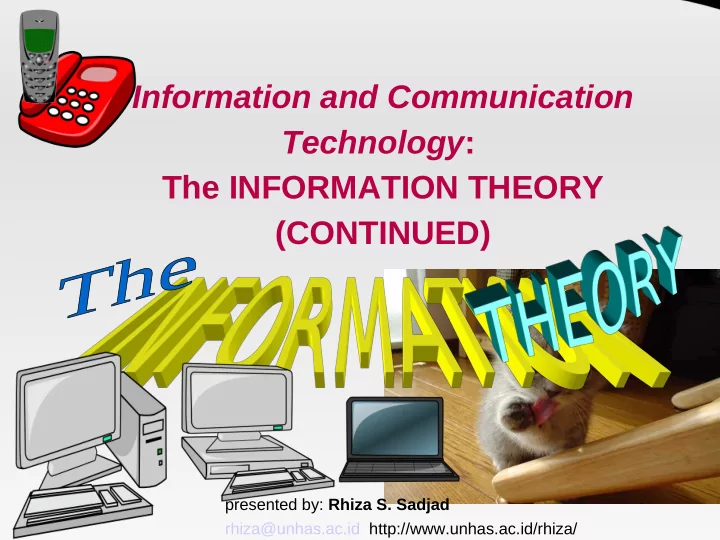

Information and Communication Technology : The INFORMATION THEORY (CONTINUED) presented by: Rhiza S. Sadjad rhiza@unhas.ac.id http://www.unhas.ac.id/rhiza/
The INFORMATION CAPACITY or Bit Rate of Data Transmission 1 bit per second 1 bps 8 to 10 bit per second 1 Byte per second 1 Bps 1000 bit per second 1 Kbps 1 Mbps 1000 Kbps 1000 Mbps 1 Gbps
The Information Capacity (Bit Rate) According to Shannon [1948], there are 2 (two) factors related to the information capacity: ◉ Bandwidth ◉ Channel Quality ( Signal to Noise Ratio , S/N atau SNR)
The Communication Model [1948] Claude E. Shannon, ” A Mathematical Theory of Communication ” (a technical notes) /home/rhiza/Desktop/shannon.pdf [1949] Claude E. Shannon and Warren Weaver, ” The Mathematical Theory of Communication ” (popular version)
The Communication Model [1948] Claude E. Shannon, ” A Mathematical Theory of Communication ” (a technical notes) /home/rhiza/Desktop/shannon.pdf [1949] Claude E. Shannon and Warren Weaver, ” The Mathematical Theory of Communication ” (popular version)
Communication Model Shannon and Weaver [ 1949 ], simplex mode INFORMATION SOURCE TRANSMITTER RECEIVED RECEIVER DESTINATION SIGNAL SIGNAL MESSAGE MESSAGE NOISE SOURCE Fig. 1 — Schematic diagram of a general communication system.
The Information Capacity (Bit Rate) Shannon and Weaver [ 1949 ], simplex mode INFORMATION SOURCE TRANSMITTER RECEIVED RECEIVER DESTINATION SIGNAL SIGNAL MESSAGE MESSAGE NOISE SOURCE Fig. 1 — Schematic diagram of a general communication system. The Shannon [ 1948 ] formula to compute the Information Capacity: Information Capacity [bps] = (Bandwidthi [Hertz])* 2 log ( 1 + S/N) Schweber , [ 1996 ], page 16
The Information Capacity (Bit Rate) The Shannon [ 1948 ] formula to compute the Information Capacity: Information Capacity [bps] = (Bandwidthi [Hertz])* 2 log ( 1 + S/N) Schweber , [ 1996 ], page 16 Bit Rate = BW * 2 log ( 1 + S/N) Bit Rate ( The Information Capacity ) : The amount of information transmitted in a unit of time [ bit per second, bps ] through a communication channel BW ( Bandwidth ) :The spectrum of signals transmittable in the channel [ Hertz , getaran per detik , cycles per second , cps ], the difference between the highest freuency and the lowest frequency S/N ( Signal to Noise ratio ) : the quality of the channel in terms of the ratio of the transmitted signal power and the noise power
The MODEs of Communication Shannon and Weaver [ 1949 ], simplex mode INFORMATION SOURCE TRANSMITTER RECEIVED RECEIVER DESTINATION SIGNAL SIGNAL MESSAGE MESSAGE NOISE SOURCE Fig. 1 — Schematic diagram of a general communication system. HALF-DUPLEX (two SIMPLEXs, one at the time) FULL-DUPLEX (two SIMPLEXs) SINGLE-SOURCE SINGLE-DESTINATION
The MODEs of Communication not a simplex mode not a full-duplex not a half-duplex, but .......... the NETWORK ! MULTI-SOURCE MULTI-DESTINATION
The NETWORK mode MULTI-SOURCE MULTI-DESTINATION
MODE JARINGAN (Network) All kinds of NETWORK: LOCAL AREA NETWORK (LAN) WIDE AREA NETWORK (WAN) METROPOLITANT AREA NETWORK (MAN) CAMPUS AREA NETWORK (CAN) The INTRANET The INTERNET MULTI-SOURCE MULTI-DESTINATION
The INTERNET ........ Read : http://en.wikipedia.org/wiki/History_of_the_Internet A “non-hierarchical” organization Members: Computers and the Accessories “Permanent” and “Temporary” members Every single member has its ”IP address” (IP = Internet Protocol) : Version 4: 000.000.000.000 to 255.255.255.255, ”local” and ”public” IP Ipv6 (version 6)
The INTERNET member........ Every single member of the Internet has its specific function: servers : mail-server, file-server, web- server, list-server, Domain-Name Server (DNS), dll........... routers: the traffic controllers bridges : connecting networks terminal , client etc.
Packet Data Communication ........ Using a communication protocol: TCP/IP Communication by sending and receiving DATA PACKETS Each DATA PACKET has its CONTENTS and its ”WRAPPER”, its SENDER's Address and its DESTINATION/RECEIVER's Address
to see .......the
Recommend
More recommend